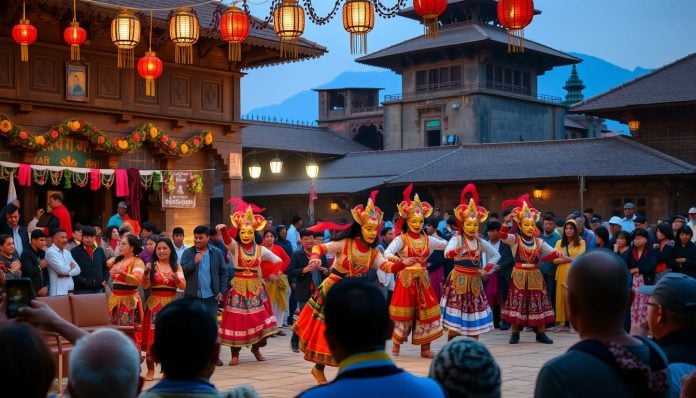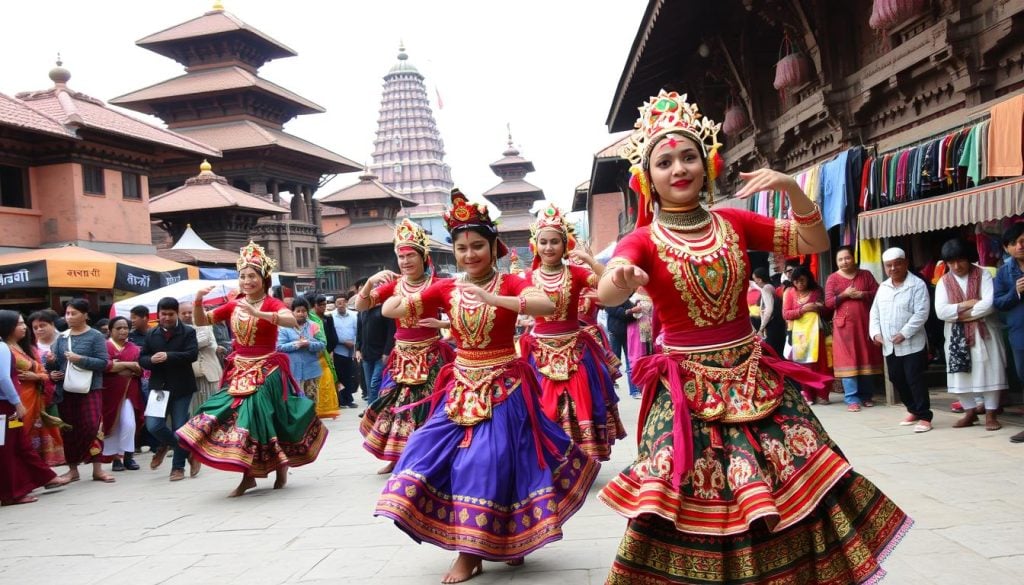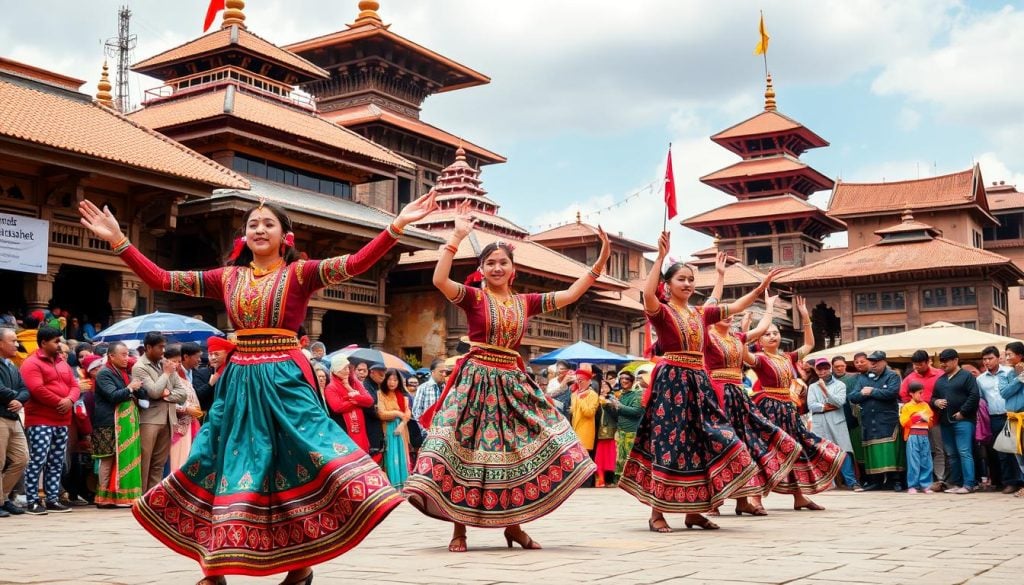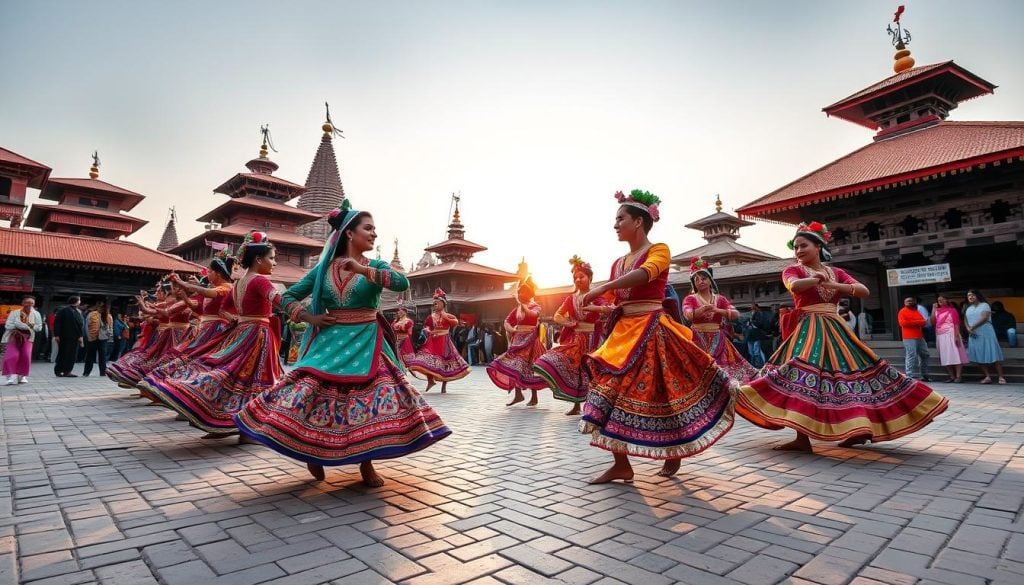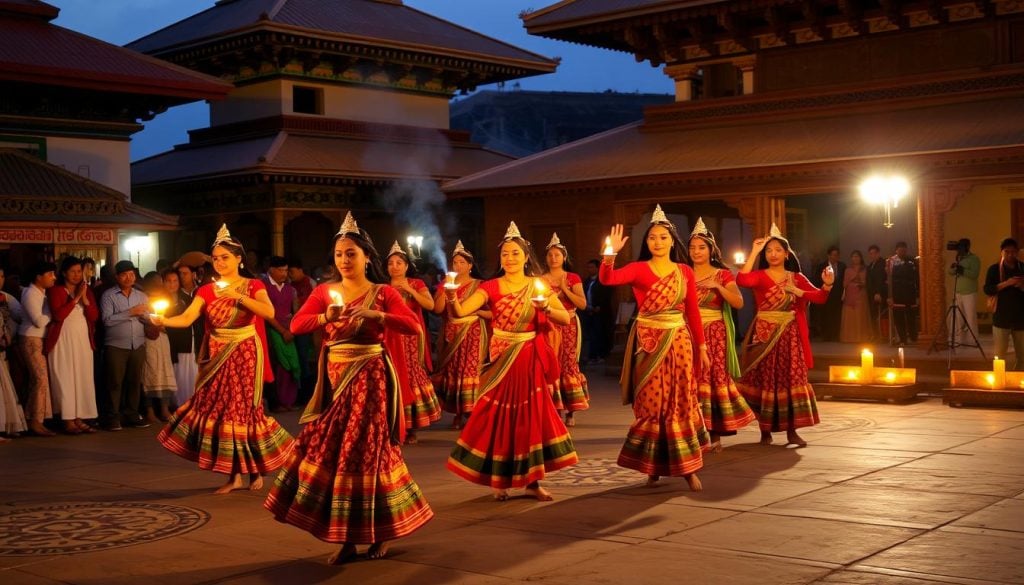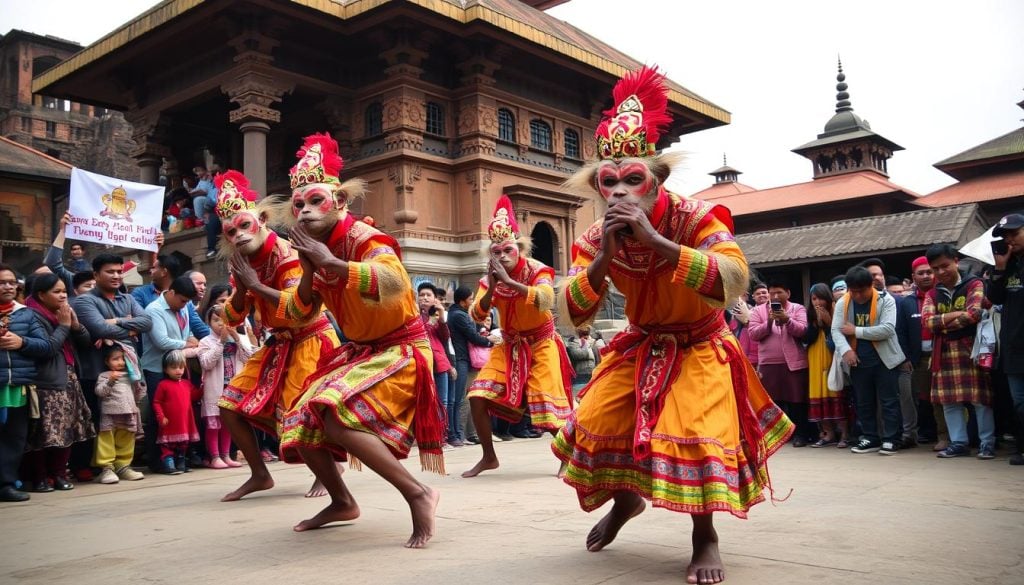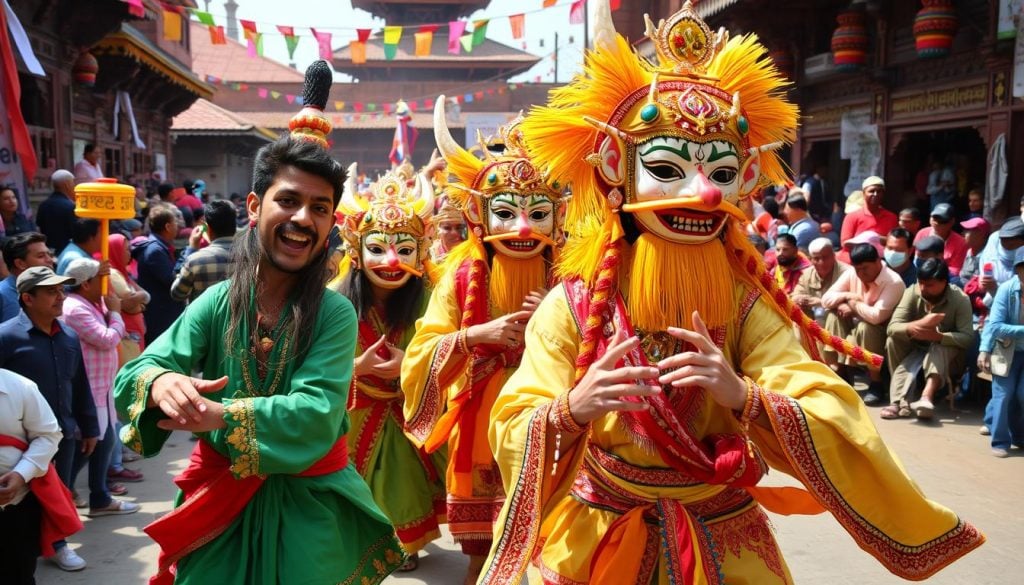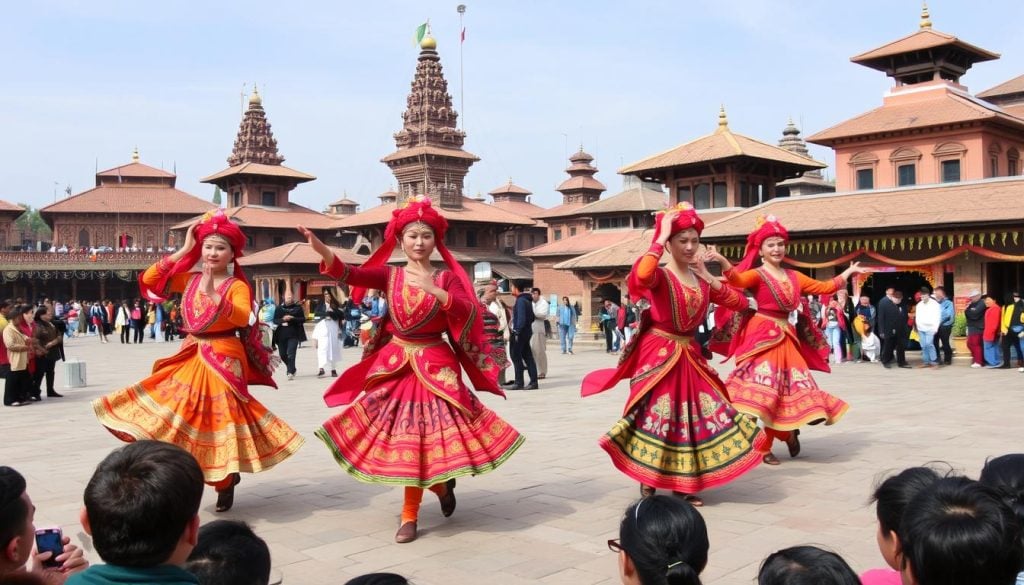Have you ever thought about how traditional dance can keep a community’s history alive? In Nepal, Bhaktapur is a cultural gem. It’s famous for its lively traditional dances that show the Newari heritage. These dances are more than just shows; they keep old customs and beliefs alive.
Exploring Bhaktapur’s traditional dances opens up a world of cultural richness. You’ll see the town’s passion for its traditions at festivals and community events. These dances let you see Bhaktapur’s dedication to its unique identity through art.
Introduction to Bhaktapur’s Cultural Heritage
Bhaktapur is a treasure trove of rich traditions and artistry. It’s a UNESCO World Heritage site known for its stunning architecture. This setting is perfect for showcasing various cultural practices, including dance.
The city’s traditions are deeply rooted in its people’s lives. They celebrate their identity through music and movement. This makes Bhaktapur a unique place where history and daily life blend together.
Bhaktapur is the heart of Newar culture, a living museum. Here, traditions of community and spirituality shine brightly. Festivals and rituals are where these values come alive. Each dance performance shares a story, showing the community’s legacy and beliefs.
Nepali folk dance in Bhaktapur is a mix of grace and fervor. It’s a big part of local life, from celebrations to religious events. These dances entertain and educate, keeping the community’s heritage alive for the future.
Understanding the Significance of Traditional Dance in Nepal
Traditional dance in Nepal is more than just entertainment. It shows the country’s rich culture and connects people. These dances tell stories, myths, and rituals from past generations. They are key parts of Nepali cultural shows, highlighting the different heritages of ethnic groups.
In Bhaktapur, traditional dance is a big part of the community. It celebrates life and honors gods, linking memories and rituals. These dances make people feel connected to their culture and heritage. They bring the community together, sharing values and identity.
These dances come to life with colorful costumes and lively rhythms. They keep history alive in today’s world. The importance of traditional dance shows its role as a link between the past and now. It lets you see the beauty and richness of Nepali traditions.
Bhaktapur Traditional Dance Performances
Bhaktapur is known for its vibrant traditional dances. These dances show off the rich Newari culture. You’ll see dances like Navadurga, Aarati, and Dhimen, each telling its own story.
Overview of the Popular Dance Forms
The dances in Bhaktapur are full of life. They have intricate moves, bright costumes, and catchy tunes. Each dance has its own special meaning:
- Navadurga Dance: This dance celebrates the goddess Durga. It shows her power and protection.
- Aarati Dance: This dance is all about devotion. It’s a beautiful performance with candle offerings.
- Dhimen Dance: This dance is all about joy. It celebrates the Newari spirit of community.
The Role of Dance in Newari Culture
Dance is very important in Newari culture. It’s not just for fun, but also for rituals and festivals. It brings people together, sharing moments of joy and sorrow.
Traditional dances teach young people about their culture. They pass on customs and values from one generation to the next. This keeps Bhaktapur’s dance traditions alive.
| Dance Form | Significance | Performance Context |
|---|---|---|
| Navadurga | Worship of Durga | Festivals, Religious Ceremonies |
| Aarati | Devotion and Prayer | Religious Ceremonies |
| Dhimen | Celebration of Life | Community Gatherings |
Navadurga Dance: The Prestigious Mask Dance
The Navadurga dance is a key part of Bhaktapur’s cultural scene. It celebrates the nine forms of goddess Durga, seen as the city’s protectors. This dance combines devotion with artistic talent through its detailed choreography.
The Nine Deities of Navadurga
Each form in the Navadurga dance has its own special traits. They show different sides of strength and protection. The main deities are:
- Mahakali: The fierce protector.
- Kumari: The living goddess symbolizing purity.
- Barahi: The boar goddess representing the earthly realm.
- Bhadrakali: The benevolent goddess of auspiciousness.
- Shitalamata: The embodiment of calm and tranquility.
- Chamunda: The goddess representing annihilation of evil.
- Lalita: The goddess of beauty and sensuality.
- Bhairavi: The fierce aspect of the divine feminine.
- Durga: The warrior goddess embodying strength and resilience.
Significance of Masks in Navadurga Dance
The masks in the Navadurga dance hold deep meaning. Made with great care, they represent the deities and their *divine spirit*. These masks are treated with rituals, linking the performers to their faith.
The masks add to the dance’s beauty and connect the audience with the story. They make the experience more engaging and spiritual.
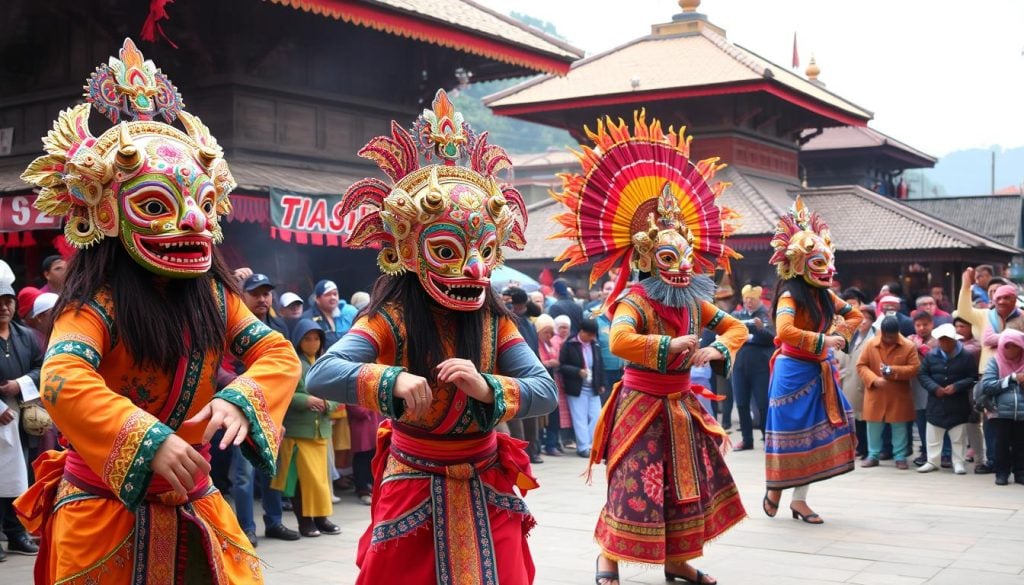
Aarati Dance: A Graceful Offering
The Aarati dance in Bhaktapur is a key part of devotion, showing the spiritual bond in Nepal’s traditional dances. Dancers move with oil lamps, symbolizing light and purity, to honor a deity. This act welcomes guests, adding to the ceremony’s sacred feel.
This dance is seen at Bhaktapur’s temples during daily prayers. Dancers move in sync with drums, drawing in the community. The Aarati dance brings people together, creating a united spiritual atmosphere.
The Aarati dance welcomes visitors, showing Newars’ cultural values. It treats each guest as a deity, showing respect and thanks. This ritual strengthens community bonds, bringing peace and prosperity. Watching or joining in this dance offers a peek into Bhaktapur’s spiritual heritage.
Dhimen Dance: Freestyle Celebration of Life
The Dhimen dance in Bhaktapur is all about celebrating life through dance. It’s a free-spirited dance that lets people connect deeply. This creates a lively atmosphere filled with rhythm and energy.
It’s often played with traditional instruments, setting the mood for the dance. People dance with joy, adding their own flair to the music. This shows off their creativity and the strong community spirit of Newari culture.
Dancing in the Dhimen style lets you express yourself and tell stories through movement. Every step and twirl is a celebration of life’s special moments. It’s more than just dancing; it’s about coming together, celebrating life, and honoring Bhaktapur’s rich culture.
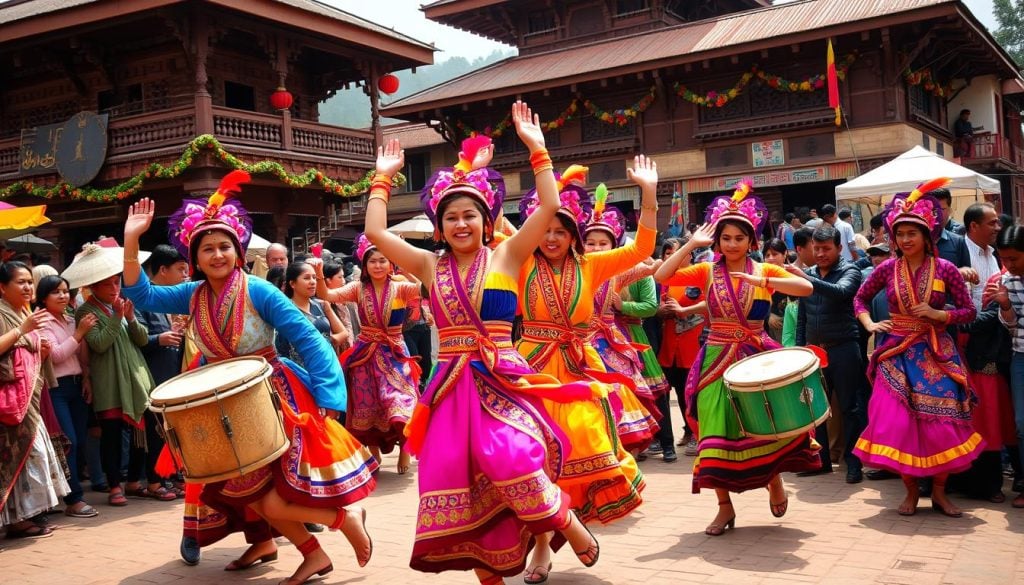
The Unique Monkey Dance of Bhaktapur
The Monkey dance Bhaktapur, also known as Makha pyakhan, is a key part of the Gai Jatra festival. It combines traditional clothes and lively movements. Dancers act like monkeys, using sticks to add to their performance.
This dance tells stories from sacred texts in a fun and meaningful way. It captivates the audience with its mix of humor and deep meaning.
Symbolism Behind the Dance
The Monkey dance holds deep cultural meaning. Monkeys in Hindu myths symbolize devotion and service to Lord Ram. The dance celebrates joy and freedom.
By performing, dancers honor their cultural heritage. This dance beautifully blends mythology, humor, and respect. It’s a beloved part of Bhaktapur’s rich traditions.
| Element | Details |
|---|---|
| Dance Name | Monkey dance Bhaktapur (Makha pyakhan) |
| Festival | Gai Jatra |
| Significance | Depicts playful spirit of monkeys in mythology |
| Themes | Joy and liberation |
| Cultural Symbolism | Devotion and service to Lord Ram |
Other Noteworthy Dances of Bhaktapur
Bhaktapur is known for its vibrant traditional dances. These dances show off the city’s rich culture. You’ll see the Khyak, Bhairav, and Kawana dances, each with its own special meaning and exciting performances.
Khyak Dance: The Mischievous Spirits
The Khyak dance is all about the fun of supernatural beings. Dancers wear fancy costumes to play these spirits. They entertain gods and people alike during festivals.
Their lively moves and fun faces grab everyone’s attention. It’s a chance to see the joy and spontaneity of the spiritual world.
Bhairav Dance: A Divine Intervention
The Bhairav dance is key in Bhaktapur’s spiritual rituals. It’s done to chase away evil spirits and bring peace to the community. This dance has deep roots, starting with King Suvarna Malla’s royal traditions.
The dance’s dramatic steps and rhythmic beats fill the air with respect. It shows off the dancers’ talent and creativity.
Kawana Dance: The Fearsome Skeletons
The Kawana dance is special because it’s done by kids dressed as skeletons. It’s a big part of Bhaktapur’s dance scene. This dance is about facing fears and celebrating life and death.
It’s a mix of fun and tradition. It’s a show that grabs everyone’s attention. It makes us think about how short life is.
| Dance Name | Primary Theme | Significance |
|---|---|---|
| Khyak Dance | Mischievous Spirits | Entertainment for gods and people |
| Bhairav Dance | Divine Intervention | Dispels evil spirits, promotes peace |
| Kawana Dance | Fearsome Skeletons | Explores life and death themes |
Festivals that Showcase Bhaktapur’s Dance Traditions
Bhaktapur is known for its lively festivals that celebrate traditional dances. These events show off the area’s rich culture and highlight the importance of community. The Gai Jatra and Biska Jatra festivals are especially notable for their dance traditions.
Gai Jatra: A Celebration of Life and Death
The Gai Jatra festival, also known as the “Cow Festival,” honors those who have passed away. It features dances like the Kawana and Bhalu, which mix humor and sadness. These dances help people celebrate and think about life and death together.
Biska Jatra: The Grand Festival of Bhaktapur
Biska Jatra in Bhaktapur is a big celebration of local culture. It includes dances like the Bhairav and Lakhey, which tell stories of good vs. evil. This festival shows the energy of local traditions and the strong bonds in Bhaktapur.
Experiencing Traditional Dance Shows in Bhaktapur
Bhaktapur gives visitors a special chance to see experiencing Nepali cultural performances. All year, cultural events and festivals fill the streets with the lively energy of traditional dance shows. These events show the heart of Newari culture and offer a peek into the traditions and artistry of the area.
Watching or joining in these Bhaktapur dance shows gives you a deep look into the detailed movements, colorful outfits, and rhythmic music. You’ll see the hard work and talent of local artists and performers. Their efforts add to Nepal’s rich cultural heritage.
Talking with performers makes the experience even better. It lets you understand the stories and meanings behind each dance. Such moments create lasting memories, connecting you to this beautiful and rich culture.
| Event | Date | Location | Description |
|---|---|---|---|
| Biska Jatra | April | Bhaktapur Durbar Square | A grand celebration featuring various dance performances and rituals. |
| Gai Jatra | August | Bhaktapur | A festival honoring the deceased, highlighted by lively dance shows. |
| Navadurga Festival | September | Bhaktapur | A showcase of the Navadurga dance, depicting myths and traditions. |
How to Participate in Local Dance Events in Bhaktapur
To dive into Bhaktapur’s lively culture, join local dance events. Start by visiting cultural centers that focus on traditional arts. There, knowledgeable staff can help you find events that match your interests.
Also, contact local tour agencies that focus on community experiences. They often connect you with workshops on different dance forms. Here, you can learn from those who live and breathe these cultural rituals.
By joining these events, you’ll make unforgettable memories. Local practitioners will share their stories and insights about each dance. This not only deepens your understanding of Newari culture but also builds lasting connections in the community.
Want to learn more about joining dance events in Nepal? Here are some opportunities:
- Participate in workshops hosted by cultural centers.
- Attend local festivals showcasing traditional dance.
- Join community gatherings focused on dance practice.
- Engage with local dancers to learn about their heritage.
| Event Type | Description | Where to Find |
|---|---|---|
| Workshops | Hands-on training in various dance forms. | Cultural centers or local tour agencies |
| Festivals | Cultural celebrations featuring multiple dance performances. | Throughout Bhaktapur, during seasonal events |
| Community Gatherings | Informal dance practices and social events. | Local neighborhoods and community centers |
Conclusion
Bhaktapur’s traditional dances are key to Nepal’s cultural heritage. They show centuries of history and spiritual importance. This summary highlights how these dances are more than shows; they tell stories of community and identity.
When you watch these dances, you support Nepal’s dance traditions. Each performance shares the Newari people’s stories, beliefs, and ways of life. It connects the old with the new, giving you a peek into Bhaktapur’s soul.
Your interest in Bhaktapur’s dances helps keep this art alive. It’s a chance to appreciate and celebrate Bhaktapur’s cultural richness. Let’s cherish this heritage together.

































